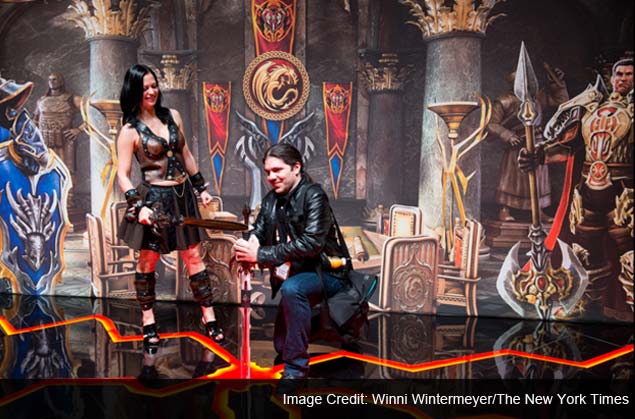- Home
- Games
- Games News
- Indies grab the controls at game conference
Indies grab the controls at game conference

But futuristic gadgets weren't the only innovations on display at the Moscone Center here, where independent designers who make text adventures and other lo-fi games can seem like bigger stars than the ones who make blockbusters. All told more than 20,000 people attended the conference last week.
When I dropped by the "'AAA-level design in a day' boot camp" on Tuesday - AAA being industry jargon for big, mainstream titles with multimillion-dollar budgets - the room was a quarter-full at best. A few hours later a near-capacity crowd of about 1,000 started queuing up more than 30 minutes in advance for a series of five-minute talks known as the "indie soapbox." Ushers held up fingers and guided people to the few remaining seats.
Indies also dominated the Game Developers Choice Awards, which were handed out Wednesday night. Journey, a downloadable game made by the independent studio thatgamecompany for the PlayStation 3, became the first independent title to win the Game of the Year award. Past winners were blockbusters like "Gears of War," "Grand Theft Auto III" and the "Sims."
By the end of that night "Journey" - which is, to be fair, decidedly high tech, gorgeous and the climax of a three-game contract between Sony and thatgamecompany - had won six of the 11 awards. "FTL: Faster Than Light," an independent game financed by a Kickstarter campaign - asking for $10,000 and receiving more than $200,000 - won the award for Best Debut.
Just two prizes went to games developed by mainstream studios. The award for Best Technology went to "Far Cry 3" (Review), an open-world, first-person shooter published by Ubisoft. The audience award went to "Dishonored," from Arkane Studios.
"The system we're fighting kind of likes us now," said Andy Schatz, an indie game designer who hosted the Independent Games Festival Awards, which preceded the Game Developers Choice Awards. "Like it or not, we're not the Clash anymore. We're Green Day."
Eric Zimmerman, a game designer and an instructor at the New York University Game Center, gave a similar explanation for why he is canceling the Game Design Challenge that he has held at the conference for the past 10 years. This year's was the last, he said.
"The idea of doing strange, bizarre, experimental games is no longer strange, bizarre or experimental," Zimmerman said.
Naturally an independent designer, Jason Rohrer, won the 2013 challenge. The theme was "Humanity's Final Game," and Rohrer designed a game within a game.
He first constructed a board game made of titanium and buried it - along with playing instructions, encased in glass - in the Nevada desert. He then provided the audience with envelopes that, in aggregate, contained more than a million GPS locations where the game might be found. Rohrer estimated that it would take one person more than 2,000 years to locate his game, as yet unplayed.
Big companies like Sony and Nintendo were at the conference, but they used much of their time to emphasize their desire to work with independent developers rather than to show off their own wares. Sony ran a "PlayStation Indie Arcade" to promote new and current titles.
The arcade culminated in a tournament of Johann Sebastian Joust, a screenless game during which selections from Bach's "Brandenburg" Concertos play while competitors try to jostle the motion-sensitive controllers in their opponents' hands while holding still the controllers in their own.
"There's always been cool, experimental stuff going on in the indie space, but it's broadened its reach," said Steve Gaynor, a co-founder of the Fullbright Co., a studio that consists of four people in a house in Portland, Ore. "It's become a lot more viable, businesswise, to be an indie." (The Fullbright Co.'s forthcoming game "Gone Home" was nominated for excellence in narrative at the independent awards.)
Because of digital distribution, game designers no longer need to have contracts with publishers - which might once have secured them vital shelf space at Wal-Mart - to succeed financially, Gaynor said. Beyond money to pay for licensed music and some voice acting, "Gone Home"'s budget basically pays for food and rent and living expenses for four people. "Our burn rate is really low," he said.
Leigh Alexander, the editor at large for Gamasutra - a trade website owned by the same company that runs the Game Developers Conference - was heartened by the indie invasion. She tweeted her one-sentence take-away: "The good guys are finally winning."
Yet she was also on a conference panel that confronted the industry for not doing enough to make women feel accepted - as designers, as players, as conferencegoers. The indie crowd is still, like the studio system, largely a men's club. (Of the 10 indie soapbox speakers, nine were men.)
"You're either doing it, or you're not," said Robin Hunicke, a designer who has worked on games like "Journey" and the "Sims 2" and who recently was co-founder of an independent studio. "You're actively working to broaden participation in our industry, or you're in the way."
Every designer starts out as a player, noted Kim McAuliffe, a designer at Microsoft Studios who most recently worked on the children's game Kinect Nat Geo TV. The limited number of playable female characters - McAuliffe could remember only Chun-Li from "Street Fighter II" and the princess in "Super Mario Bros. 2" from her childhood - necessarily limits the audience for female players, she said, and thus reduces the number of female game designers.
McAuliffe also said she was uncomfortable with the large number of games that involve shooting human characters. "I worked on 'Socom 4,"' a military shooter, "but it made me uncomfortable every time I played my own levels," she said.
The number of women in the industry is growing, said Brenda Romero, the game designer in residence at the University of California, Santa Cruz, and the creator of acclaimed board games, like Train, about the Holocaust. After all, she said, "2006 was the first year there was a line at the women's bathroom at GDC."
But, she added, industry traditions like the "booth babes" at the annual Electronic Entertainment Expo, known as E3, need to end before women will feel fully welcome.
Romero's 12-year-old daughter told her that her dream was to make a video game with her. For now, though, Romero is unwilling to take her daughter into what she called E3's "sexually charged environment," one that she compared to a leering crowd at a construction site.
Appealing directly to the organizers of E3, Romero concluded the panel by saying, "Please change this, so I can bring her there."
© 2013, The New York Times News Service
Catch the latest from the Consumer Electronics Show on Gadgets 360, at our CES 2026 hub.
- Samsung Galaxy Unpacked 2025
- ChatGPT
- Redmi Note 14 Pro+
- iPhone 16
- Apple Vision Pro
- Oneplus 12
- OnePlus Nord CE 3 Lite 5G
- iPhone 13
- Xiaomi 14 Pro
- Oppo Find N3
- Tecno Spark Go (2023)
- Realme V30
- Best Phones Under 25000
- Samsung Galaxy S24 Series
- Cryptocurrency
- iQoo 12
- Samsung Galaxy S24 Ultra
- Giottus
- Samsung Galaxy Z Flip 5
- Apple 'Scary Fast'
- Housefull 5
- GoPro Hero 12 Black Review
- Invincible Season 2
- JioGlass
- HD Ready TV
- Laptop Under 50000
- Smartwatch Under 10000
- Latest Mobile Phones
- Compare Phones
- OPPO Reno 15 Pro Max
- Honor Win RT
- Honor Win
- Xiaomi 17 Ultra Leica Edition
- Xiaomi 17 Ultra
- Huawei Nova 15
- Huawei Nova 15 Pro
- Huawei Nova 15 Ultra
- Asus ProArt P16
- MacBook Pro 14-inch (M5, 2025)
- OPPO Pad Air 5
- Huawei MatePad 11.5 (2026)
- Xiaomi Watch 5
- Huawei Watch 10th Anniversary Edition
- Acerpure Nitro Z Series 100-inch QLED TV
- Samsung 43 Inch LED Ultra HD (4K) Smart TV (UA43UE81AFULXL)
- Asus ROG Ally
- Nintendo Switch Lite
- Haier 1.6 Ton 5 Star Inverter Split AC (HSU19G-MZAID5BN-INV)
- Haier 1.6 Ton 5 Star Inverter Split AC (HSU19G-MZAIM5BN-INV)












